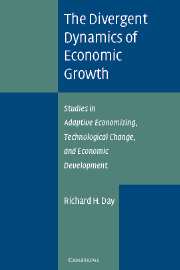 The Divergent Dynamics of Economic Growth
The Divergent Dynamics of Economic Growth Book contents
- Frontmatter
- Contents
- Preface
- Acknowledgments and Comments
- 1 The Adaptive, Evolutionary Theory of Divergent Economic Growth
- PART ONE GLOBAL TRENDS AND ADAPTIVE ECONOMICS
- PART TWO TECHNOLOGICAL CHANGE IN AGRICULTURE AND INDUSTRY
- PART THREE EPOCHAL DEVELOPMENT
- PART FOUR TOWARD A GENERAL THEORY OF DEVELOPMENT
- 11 Economics Far from Equilibrium
- 12 The Dialectical Republic
- Index
12 - The Dialectical Republic
Toward a General Theory of the Coevolution of Market and State
Published online by Cambridge University Press: 08 August 2009
- Frontmatter
- Contents
- Preface
- Acknowledgments and Comments
- 1 The Adaptive, Evolutionary Theory of Divergent Economic Growth
- PART ONE GLOBAL TRENDS AND ADAPTIVE ECONOMICS
- PART TWO TECHNOLOGICAL CHANGE IN AGRICULTURE AND INDUSTRY
- PART THREE EPOCHAL DEVELOPMENT
- PART FOUR TOWARD A GENERAL THEORY OF DEVELOPMENT
- 11 Economics Far from Equilibrium
- 12 The Dialectical Republic
- Index
Summary
Existence is either ordered in a certain way, or it is not so ordered, and conjectures which harmonize best with experience are removed above all comparison with conjectures which do not so harmonize.
Thomas HardyVarious kinds of simple dynamic economic behavior are well understood: the existence and character of stationary states, steady or balanced economic growth, and periodic business cycles. Each of these types of behavior has its corresponding explanation or set of alternative explanations. Theories of general equilibrium explain stationary states or steady, balanced growth. Theories of business cycles explain periodic oscillations in the economy. Unfortunately, simple dynamic behavior is not exhibited by typical economies of record. Instead, they manifest complex dynamics: irregular fluctuations, overlapping waves of development, structural change, and institutional evolution.
If there were a tendency for economies to converge to simple dynamic paths within a fixed institutional framework, the irregularity of economic behavior would be unimportant because the departure from balanced growth or cycles would eventually abate; theories of the steady state and of cycles would approximate with ever greater accuracy the path of actual events, and society would settle down once and for all to a fixed organizational structure. But this is not the case. If anything, the pace of change has accelerated with the advance of human progress; the durations of growth and decay periods have correspondingly shortened.
- Type
- Chapter
- Information
- The Divergent Dynamics of Economic GrowthStudies in Adaptive Economizing, Technological Change, and Economic Development, pp. 221 - 236Publisher: Cambridge University PressPrint publication year: 2003
